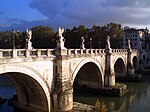Gemarrin Bridge | |
|---|---|
 Remains of the Gemarrin Bridge, view from southeast | |
| Coordinates | 32°32′58″N36°29′46″E / 32.549389°N 36.496028°E |
| Carries | Roman road to As-Suwayda |
| Crosses | Wadi Zeidi |
| Locale | Close to Bosra, Syria |
| Characteristics | |
| Design | Arch bridge |
| Material | Basalt blocks |
| No. of spans | 3 |
| Location | |
 | |
The Bridge of Gemarrin is a Roman bridge in the village of Jemarrin near the ancient city of Bosra in southern Syria. The bridge belonged to the Roman road to Soada Dionysias (As-Suwayda), crossing the Wadi Zeidi some kilometers north of Bostra. [1]
Contents
Today, the structure presents itself essentially as an arch skeleton: while the three semi-circular arches, made from local basalt, are still extant, the roadway and the fill have been removed to expose the top of the arch vaults. [2] Obliquely running embankments on both sides of the wadi force the water in the river bed under the bridge. [3]
At least two other Roman bridges over the Wadi Zeidi, the Kharaba Bridge and the one At-Tayyibeh, have survived to this day. [1]
